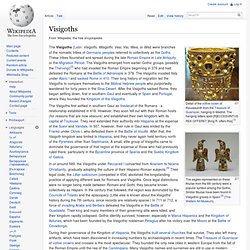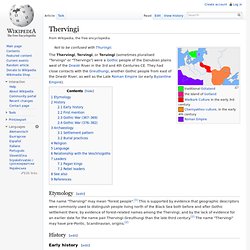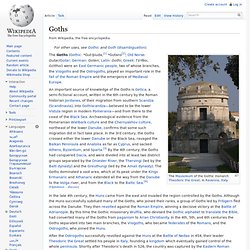

Gepids. The Roman empire under Hadrian (ruled 117-38), showing the location of the Gepidae (Gepids) East Germanic tribe, then inhabiting the region around the mouth of the Visula (Vistula) river, Poland The Gepids (Latin: Gepidae; Old English: Gifð; possibly Proto-Germanic: *Gibiðaz, "giver"[1] or gepanta) were an East Germanic tribe who were closely related to the Goths.[2] The Gepids were recorded in the area along the southern Baltic coast in the 1st century AD, having migrated there from southern Sweden some years earlier.

Crimean Goths. Archaeological evidence of the Crimean Goths in Crimea Map of Gothia – territory of the Crimean Goths Crimean Goths were those Gothic tribes who remained in the lands around the Black Sea, especially in Crimea.

They were the least-powerful, least-known, and almost paradoxically, the longest-lasting of the Gothic communities. Their existence is well attested through the ages though the exact period when they ceased to exist as a distinct culture is unknown; as with the Goths in general, they may have been diffused with the surrounding peoples. In the Fourth Turkish letter by Ogier Ghiselin de Busbecq, they are described as "a warlike people, who to this day inhabit many villages" though in the 5th century, Theodoric the Great failed to rouse Crimean Goths to support his war in Italy.[1] At the time, it was customary to refer to a wide range of Germanic tribes as "Goths", so the exact ethnic origin of the Germanic peoples in the Crimea is a subject of debate.
Definition[edit] Ostrogoths. Visigoths. The eagles represented on these fibulae from the 6th century were a popular symbol among the Goths.

Similar fibulae have been found in Visigothic graves in Spain.[2] (The Walters Art Museum) The Visigoths first settled in southern Gaul as foederati of the Romans - a relationship established in 418. However, they soon fell out with their Roman hosts (for reasons that are now obscure) and established their own kingdom with its capital at Toulouse. They next extended their authority into Hispania at the expense of the Suevi and Vandals. Greuthungi. Thervingi. The Thervingi, Tervingi, or Teruingi (sometimes pluralised "Tervings" or "Thervings") were a Gothic people of the Danubian plains west of the Dnestr River in the 3rd and 4th Centuries CE.

They had close contacts with the Greuthungi, another Gothic people from east of the Dnestr River, as well as the Late Roman Empire (or early Byzantine Empire). Etymology[edit] The name "Thervingi" may mean "forest people".[1] This is supported by evidence that geographic descriptors were commonly used to distinguish people living north of the Black Sea both before and after Gothic settlement there, by evidence of forest-related names among the Thervingi, and by the lack of evidence for an earlier date for the name pair Thervingi-Greuthungi than the late third century.[2] The name "Thervingi" may have pre-Pontic, Scandinavian, origins.[2] History[edit] Early history[edit] First mention[edit] Gothic War (367–369)[edit]
Goths. The Goths (Gothic: *Gut-þiuda,[1] *Gutans[2]; Old Norse: Gutar/Gotar; German: Goten; Latin: Gothi; Greek: Γότθοι, Gótthoi) were an East Germanic people, two of whose branches, the Visigoths and the Ostrogoths, played an important role in the fall of the Roman Empire and the emergence of Medieval Europe.

An important source of knowledge of the Goths is Getica, a semi-fictional account, written in the 6th century by the Roman historian Jordanes, of their migration from southern Scandza (Scandinavia), into Gothiscandza—believed to be the lower Vistula region in modern Pomerania—and from there to the coast of the Black Sea. Archaeological evidence from the Pomeranian Wielbark culture and the Chernyakhov culture, northeast of the lower Danube, confirms that some such migration did in fact take place. Gothic language and culture largely disappeared during the Middle Ages, although its influence continued to be felt in small ways in some western European states. Etymology[edit]